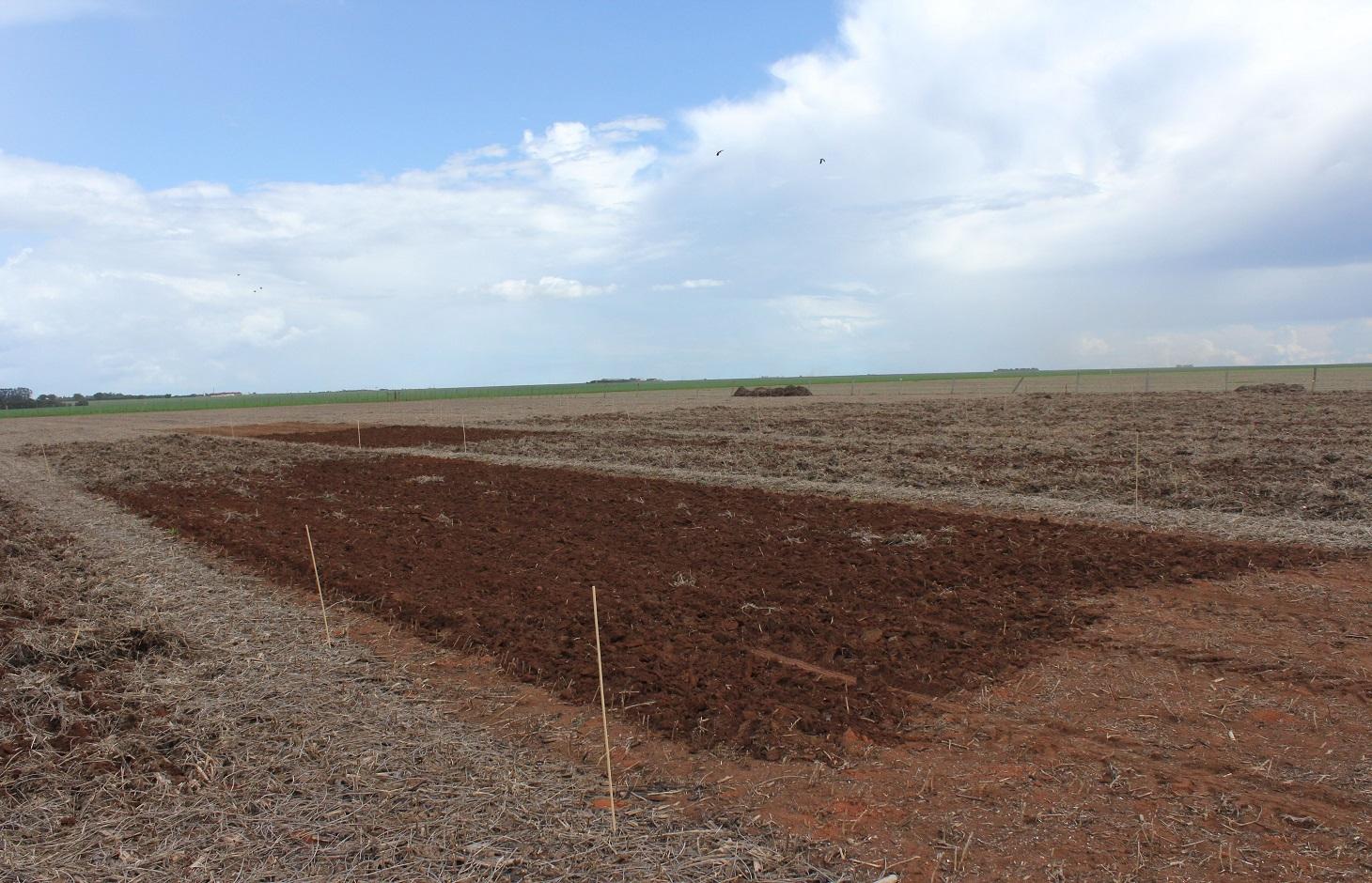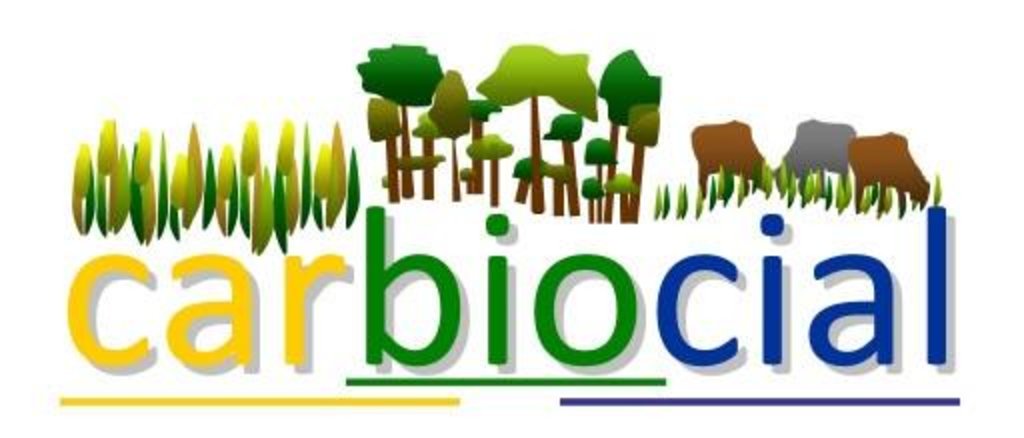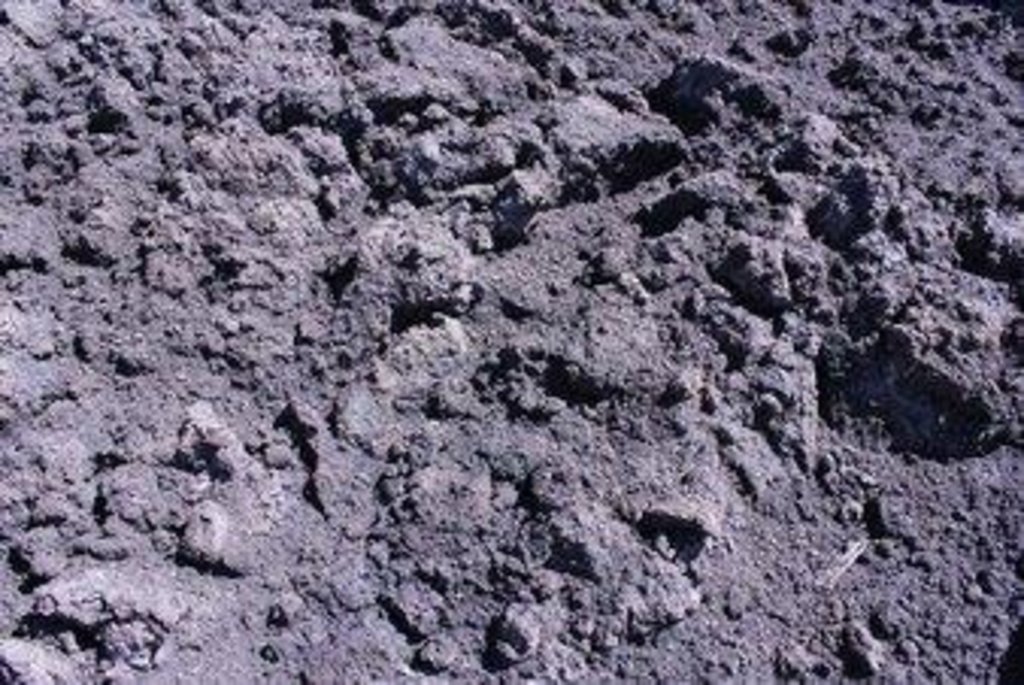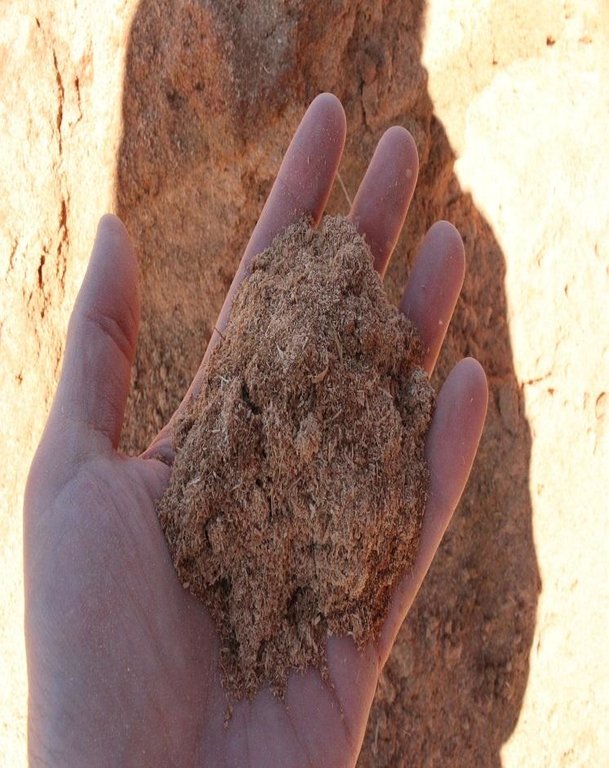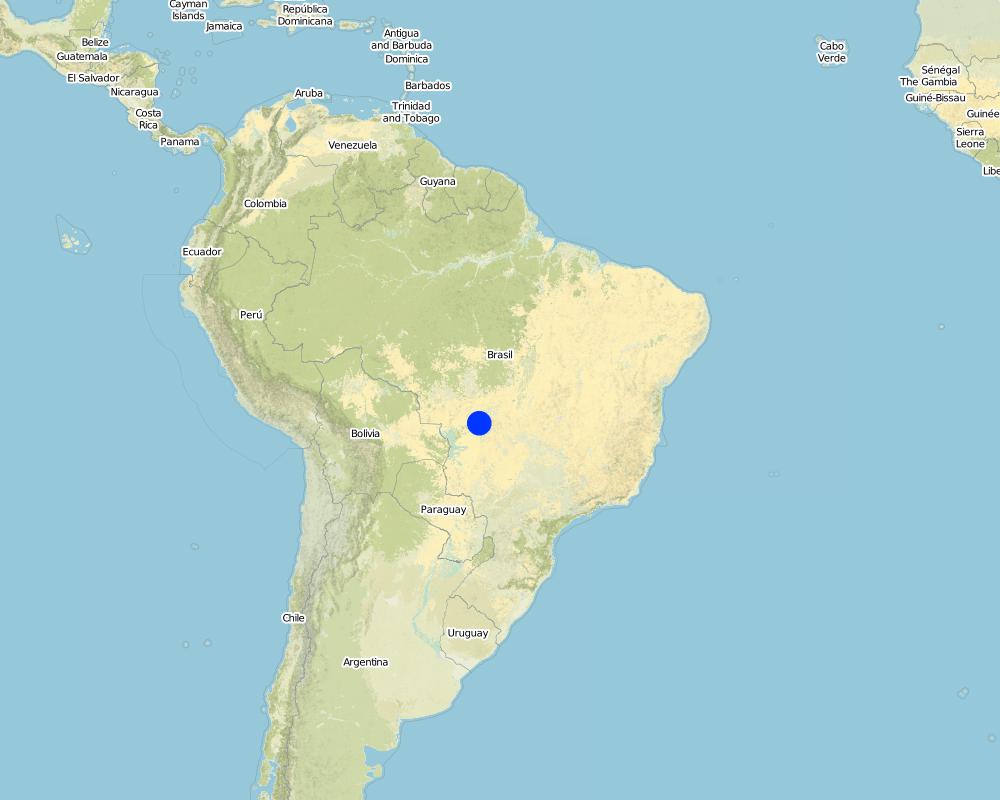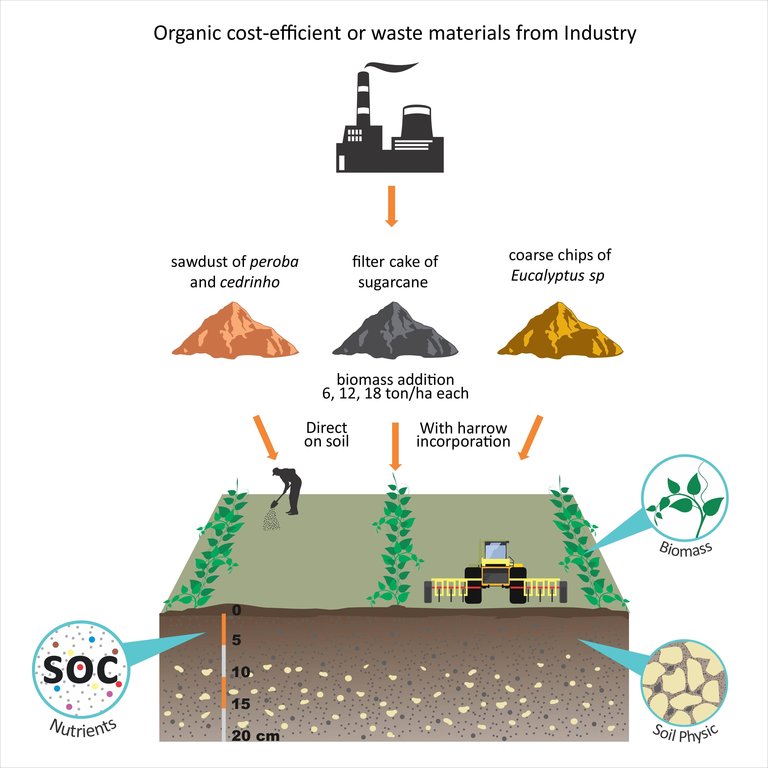Carbon-enrichment of tropical agricultural soil with organic matter [Бразилия]
- Создание:
- Обновить:
- Составитель: Luisa F. Vega
- Редактор: –
- Рецензенты: Alexandra Gavilano, Deborah Niggli, David Streiff
Enriquecimento de carbono em solo de lavoura com matéria orgânica (Brazil)
technologies_1250 - Бразилия
- Полная аннотация в формате PDF
- Полная аннотация в формате PDF для вывода на печать
- Полная аннотация в формате интернет-страницы
- Полная аннотация (неотформатированно)
- Carbon-enrichment of tropical agricultural soil with organic matter: 5 января 2017 г. (inactive)
- Carbon-enrichment of tropical agricultural soil with organic matter: 7 марта 2017 г. (inactive)
- Carbon-enrichment of tropical agricultural soil with organic matter: 29 апреля 2017 г. (inactive)
- Carbon-enrichment of tropical agricultural soil with organic matter: 7 марта 2019 г. (public)
Просмотреть разделы
Развернуть все Свернуть все1. Общая информация
1.2 Контактные данные специалистов и организаций, участвующих в описании и оценке Технологии
Специалист по УЗП:
Irmler Prof. Dr. Ulrich
Institute for Ecosystem Research
Германия
Специалист по УЗП:
Wantzen Prof. Dr. Karl M.
CNRS UMR CITERES
Франция
Название проекта, содействовавшего документированию/оценке Технологии (если применимо)
Book project: Making sense of research for sustainable land management (GLUES)Название проекта, содействовавшего документированию/оценке Технологии (если применимо)
Carbon optimized land management strategies for southern Amazonia (CARBIOCIAL / GLUES)Название организации (-ий), содействовавших документированию/оценке Технологии (если применимо)
University of Kiel (University of Kiel) - ГерманияНазвание организации (-ий), содействовавших документированию/оценке Технологии (если применимо)
Universidade Federal de Mato Grosso (Universidade Federal de Mato Grosso) - БразилияНазвание организации (-ий), содействовавших документированию/оценке Технологии (если применимо)
Université Francois-Rabelais de Tours (Université Francois-Rabelais de Tours) - Франция1.3 Условия, регламентирующие использование данных, собранных ВОКАТ
Составитель и ответственный(-ые) специалист(-ы) согласны с условиями, регламентирующими использование собранных ВОКАТ данных:
Да
1.4 Декларация по устойчивости описываемой Технологии
Вызывает ли описанная здесь Технология проблемы деградации земель настолько, что ее нельзя назвать природосберегающей?
Нет
1.5 Ссылка на Анкету (ы) по Подходам УЗП (документируется с использованием ВОКАТ)
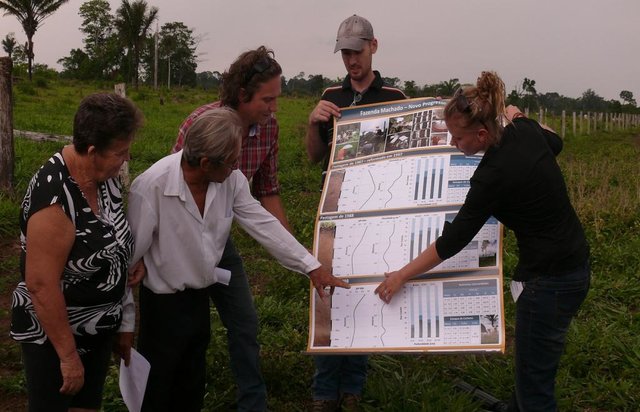
From storylines to scenarios: raising awareness and decision … [Бразилия]
Investigating viable carbon-optimized land management strategies, which maintain or improve ecosystem function, under changing climate conditions in the Southern Amazon - using regional scenarios generated from storylines.
- Составитель: Jan Goepel
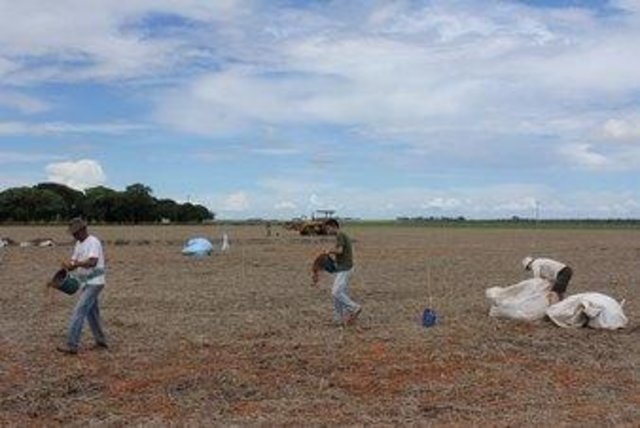
Enrichment of Tropical Agricultural Soil with Organic Matter [Бразилия]
Enrichment of tropical agicultural soils with local available organic matter in the cerrado agroscape, Brazil.
- Составитель: Luisa F. Vega
2. Описание Технологии УЗП
2.1 Краткое описание Технологии
Определение Технологии:
Carbon-enrichment of tropical agricultural soils with locally available organic matter in the Cerrado agricultural landscape, Brazil.
2.2 Подробное описание Технологии
Описание:
In the Carbiocial Project viable land management strategies were explored to optimize the level of carbon in soil and water, helping to maintain and/or improve ecosystem functions, under changing climatic conditions in the Southern Amazon and the Brazilian Cerrado. In the framework of this project, on-farm experiments were performed to enrich tropical agricultural soils in the medium term, with different types of organic matter (OM). In the experiment the effect of different types of OM amendments on soil carbon and macro-nutrients (N, P, and K), soil physical properties (waterholding capacity) and crop yield (soy biomass and grain production) were assessed. The amendments applied are locally available, and are either free (being waste materials) or considered cost-efficient.
The objective of this on-going experiment is to compare the impact of (i) the quality and quantity of OM applied, (ii) and the application methods (directly on the soil surface or incorporation by harrow) on soil chemical and physical properties. It is hypothesised that the addition of OM can enhance crop yields and, potentially, soil biodiversity. The effects of the different OM types, amounts and application methods were evaluated after one, two and three years. From the results, the aim is to provide recommendations for the development of soil OM-enrichment schemes and carbon-friendly landscape management programs for farmers, using local resources.
The experiment was established on an area of about one hectare on a ferrasol (red latosol) at the Rio Engano Farm, in the municipality of Campo Verde, Mato Grosso State. The farm has a total area of ca. 1500 ha, 830 ha of which are cultivated with soybean and maize rotation, under a zero-tillage system, which is typical of many farms in this region. It is located in the Brazilian Cerrado (savanna) biome at about 685 m a.s.l. This biome covers 2 million km2, which is 23% of the country area. It has a semi-humid climate with a pronounced dry season. The precipitation during the rainy season (September-April) varies between 800 and 2000 mm/year.
At the beginning of the experiment (February 2012), three different types of OM amendments were applied. They comprised (a) sugarcane filter cake (Saccharum officinarum from ethanol/sugar-production, (b) sawdust of peroba and cedrinho (Peroba jaune and Erisma uncinatum, respectively) and (c) coarse chips of Eucalyptus sp. Quantities applied were 0 (control), 6, 12 and 18 tonnes of each per hectare; using two methods: directly on the soil surface, and incorporated by harrow. There were three repetitions per treatment. The area was not fenced to allow the farmers to continue with their field routines on all plots. In February 2013, 2014 and 2015 soil samples were taken to analyze their chemical and physical properties. Soybean samples were also taken in February 2014 and 2015 to estimate biomass and grain production. From the initial results some conclusions can be drawn: 1) Organic amendment addition to ferrasols can significantly increase soil organic carbon, even in amounts as low as 6 t/ha. 2) Amendments should be reapplied every 2 years. 3) The amendment type and application method does not have a significant effect on increasing soil organic carbon. 4) The addition of OM amendments is a win-win situation as a solution for organic matter waste recycling, and simultaneously to improve soil quality.
The area was not fenced to allow the farmer to continue with their arable field routines on all treatment plots. In February 2013, 2014 and 2015 soil samples were taken to analyze their chemical and physical properties. Soy bean samples were also taken in February 2014 and 2015 to estimate biomass and grain production.
From our first results we can draw some conclusions:
1) Organic amendment addition to Ferrasol can increase significantly soil organic carbon (SOC) percentage, even in small amounts such as 6 ton/ha.
2) Amendment reapplication should be done in 2 years intervals.
3) The amendment type and disposition did not have a significant effect on increasing SOC.
4) The addition of OM amendments is a win-win situation as a solution for organic matter waste recycling and to improve soil quality.
2.3 Фотографии, иллюстрирующие Технологию
2.5 Страна/ регион/ места, где применяется Технология, информация о которых собрана в данной Анкете
Страна:
Бразилия
Административная единица (Район/Область):
Mato Grosso
Более точная привязка места:
Campo Verde
Охарактеризуйте пространственное распространение Технологии :
- равномерно-однородное применение на определенной площади
Если технология равномерно занимает территорию, укажите площадь покрытия (в км2):
0,011544
Пояснения:
Total area covered by the SLM Technology is 0.011544 km2.
In the São Valentim Farm, located in the Brazilian Cerrado (savanna) biome. The experimental soil enrichment was established in February 2012, on a Ferrasol. The area was under a soybean-corn crop rotation
Map
×2.6 Сколько лет применяется данная Технология
Если год начала применения Технологии достоверно неизвестен, дайте примерную оценку:
- менее 10 лет назад (недавняя)
2.7 Внедрение Технологии
Укажите, как именно Технология УЗП была внедрена:
- в качестве научного/ полевого эксперимента
- через проекты/ внешнее вмешательство
Пояснения (тип проекта и т.д.):
The enrichment of the soil by OM application is a traditional practice. Some of the added OM types in this experimet are already used in the Cerrado without any technical specification. This project aim to identify of one or more types, amounts and application methods of OM, which improve significantly soil quality and carbon stock. The OM effects are evaluated after 2 and 3 years of its addition, which was initially done in February 2012.
3. Классификация Технологии УЗП
3.1 Основные цели и задачи реализации Технологии
- повышение производства
- сохранение экосистем
3.2 Текущий(-ие) тип(-ы) землепользования на территории, где применяется Технология
Комбинированное землепользование в пределах одной и той же земельной единицы:
Да
Укажите сочетания типов землепользования (посевы / пастбища / деревья):
- Агро-пастбищное хозяйство ( включая растениеводство-животноводство)

Пахотные угодья и плантации
- Однолетние культуры
Число урожаев за год:
- 2
Поясните:
Longest growing period in days: 150, Longest growing period from month to month: November to March; Second longest growing period in days: 120, Second longest growing period from month to month: April to July

Пастбищные угодья
Экстенсивный выпас:
- Загонно-порционное
Интенсивный выпас/ выращивание кормов:
- Стойловое содержание/ нулевой выпас
Пояснения:
Major land use problems (compiler’s opinion): Croplands demonstrate a reduction in soil organic matter, after their conversion from indigenous vegetation into agricultural fields. It is especially critical in the ferrasol soils of the Brazilian Cerrado, as its organic matter content is relatively low, and tropical temperatures and humidity accelerate microbial activity (Price and Sowers 2004)
Major land use problems (land users’ perception): There are also problems regarding soil compaction and rainfall regime change
Grazingland comments: There is some grazing by tapir, capibara, wild pig, ema, papagay
Type of grazing system comments: There is some grazing by tapir, capibara, wild pig, ema, papagay
Livestock density: > 100 LU /km2
3.4 Водоснабжение
Обеспеченность водой участков, где реализуется Технология :
- богарные земли
3.5 Категория УЗП, к которой относится Технология
- Комплексное управление почвенным плодородием
3.6 Мероприятия УЗП, выполняемые в рамках Технологии

Агрономические мероприятия
- A2: Органическое вещество/ почвенное плодородие
- A3: Поверхностная обработка почв
- A4: Глубокая обработка почв
Пояснения:
Type of agronomic measures: manure / compost / residues, zero tillage / no-till, non-inversion tillage
3.7 Основные проблемы деградации земель, на решение которых направлена Технология

водная эрозия почв
- ВЭп: поверхностная эрозия/смыв верхних почвенных горизонтов

ухудшение химических свойств почв
- Хп: Снижение плодородия и уменьшение содержания органического вещества (вызванное не эрозией, а другими причинами)

ухудшение физических свойств почв
- Фу: уплотнение

биологическая деградация
- Бв: потеря природного разнообразия
Пояснения:
Main causes of degradation: soil management (Extensive areas of monoculture), crop management (annual, perennial, tree/shrub) (Intensive soil use), deforestation / removal of natural vegetation (incl. forest fires) (In the region, the native vegetation of Cerrado was deforested during the early 80´s for agricultural purposes.), population pressure (Most of the agricultural production from The Brazilian Cerrado meet the food demand from Europe and China)
Secondary causes of degradation: Heavy / extreme rainfall (intensity/amounts) (There is an increase of extreme rainfall events which take place during the rainy season), labour availability (Reduction of availability of skilled labor for instance, to carry out integral monitoring of plagues), education, access to knowledge and support services (There a positive relationship between education level of farmers and the adoption of new technologies for sustainable land management), governance / institutional (Part of the colonization and conversion of the Brazilian Cerrado into agricultural systems was encouraged by Research (Embrapa) and Financing Government Programs)
3.8 Предотвращение и снижение деградации земель, или восстановление нарушенных земель
Укажите цель Технологии по отношению к деградации земель :
- снижение деградации земель
4. Технические характеристики, мероприятия по практической реализации, вложения и стоимость
4.1 Технический рисунок, иллюстрирующий Технологию
Спецификация (пояснения к техническому рисунку):
Enrichment of Tropical agricultural soil (Ferrasol) with organic matter amendments. Experimental design: amendment types, amounts and disposition methods (direct on the soil or with harrow incorporation). Studied variables: soil carbon and nutrients, soil physical properties (water holding capacity) and crop yield (soy biomass and grain production).
Location: Rio Engano Ranch. Campo Verde / Mato Grosso / Brazil
Date: 6.11.2015
Technical knowledge required for field staff / advisors: low
Technical knowledge required for land users: low
Main technical functions: increase in organic matter, increase / maintain water stored in soil
Secondary technical functions: control of raindrop splash, control of dispersed runoff: impede / retard, improvement of topsoil structure (compaction), stabilisation of soil (eg by tree roots against land slides), increase in nutrient availability (supply, recycling,…), increase of infiltration, increase of groundwater level / recharge of groundwater, water harvesting / increase water supply
Manure / compost / residues
Material/ species: (a) Filter cake of sugarcane residues (Saccharum officinarum from alcohol/sugar-production, (b) saw
Quantity/ density: 6, 12, 18
Zero tillage / no-till
Remarks: A part of the organic matter was added directly on the soil surface
Non-inversion tillage
Remarks: Another part of the organic matter was incorporate into the soil by using harrow
Автор:
Diego Orduz, orduzrobles@gmail.com
4.2 Общая информация по необходимым вложениям и стоимости
другая/ национальная валюта (название):
BRL
Если это необходимо, укажите обменный курс от доллара США к местной валюте (например, 1 доллар США = 79,9 бразильского реала): 1 доллар США =:
4,0
Укажите среднюю дневную заработную плату наемных работников:
25.00
4.4 Вложения и затраты, необходимые для начала реализации
Пояснения:
Duration of establishment phase: 0 month(s)
4.5 Поддержание/ текущее обслуживание
| Деятельность | Сроки/ повторяемость проведения | |
|---|---|---|
| 1. | 1.Transport of amendments by trucks (0.2 tonne/US$) | |
| 2. | 2.Spreading / incorporation of organic matter by tractor (US$ 3/ha for petrol and US$ 5/ha for tractor driver). |
4.6 Стоимость поддержания/ текущего обслуживания ( в год)
| Опишите затраты | Единица | Количество | Затраты на единицу | Общая стоимость на единицу | % затрат, оплаченных землепользователями | |
|---|---|---|---|---|---|---|
| Оплата труда | labour | ha | 1,0 | 5,0 | 5,0 | 100,0 |
| Оборудование | machine use | ha | 1,0 | 15,0 | 15,0 | 100,0 |
| Оборудование | truck transport | ha | 1,0 | 150,0 | 150,0 | 100,0 |
| Общая стоимость поддержания Технологии | 170,0 | |||||
| Общие затраты на поддержание Технологии в долларах США | 42,5 | |||||
4.7 Наиболее значимые факторы, влияющие на стоимость затрат
Опишите наиболее значимые факторы, влияющие на стоимость затрат:
Amendment truck transport (0,2 ton/US$), amendment application by tractor(15 US$*ha/dia)
and tractor driver (5 US$*ha) costs.
The used organic matter amendments are cost-free. It is suggested to use cost-free materials if possible or cost–efficient materials to reduce implementation and maintenance costs. Transport of amendments is paid by tonne, independently of the type. The OM application methods (direct on the soil by hand or with harrow incorporation) did not show significant differences. For this reason only the costs for the tractor were calculated, because it is a more economic option.
5. Природные и социально-экономические условия
5.1 Климат
Среднегодовое количество осадков
- < 250 мм
- 251-500 мм
- 501-750 мм
- 751-1000 мм
- 1001-1500 мм
- 1501-2000 мм
- 2001-3000 мм
- 3001-4000 мм
- > 4000 мм
Пояснения/ комментарии по осадкам:
The area presents strong seasonality: dry season (May-Sep) and rainy season (Oct-Apr)
Агроклиматическая зона
- Умеренно-влажная
Thermal climate class: tropics
5.2 Рельеф
Склоны (преобладающие):
- пологие (0-2%)
- покатые (3-5%)
- покато-крутые (6-10%)
- крутые (11-15%)
- очень крутые (16-30%)
- чрезвычайно крутые (31-60%)
- обрывистые (>60%)
Формы рельефа:
- плато/ равнины
- гребни хребтов/холмов
- склоны гор
- склоны холмов
- подножья
- днища долин
Зона высотной поясности:
- 0-100 м над уровнем моря
- 101-500 м н.у.м.
- 501-1000 м н.у.м.
- 1001-1500 м н.у.м.
- 1501-2000 м н.у.м.
- 2001-2500 м н.у.м.
- 2501-3000 м н.у.м.
- 3001-4000 м н.у.м.
- > 4 тыс. м н.у.м.
5.3 Почвы
Средняя мощность почв:
- поверхностные (0-20 см)
- неглубокие (21-50 см)
- умеренно глубокие (51-80 см)
- глубокие (81-120 см)
- очень глубокие (> 120 см)
Гранулометрический состав (верхнего горизонта):
- тонкодисперсный/ тяжёлый (глинистый)
Содержание органического вещества в верхнем горизонте:
- высокое (> 3%)
5.4 Доступность и качество воды
Уровень грунтовых вод:
5-50 м
Доступность поверхностных вод:
хорошая
Качество воды (без обработки):
исключительно для сельскохозяйственного использования (орошение)
5.5 Биоразнообразие
Видовое разнообразие:
- низкое
5.6 Характеристика землепользователей, применяющих Технологию
Рыночная ориентация производства:
- товарное/ рыночное хозяйство
Доходы из других источников:
- < 10% всех доходов
Относительный уровень достатка:
- средний
- обеспеченный
Индивидуальное или коллективное хозяйство:
- частное/ домовладение
Уровень механизации:
- механизировано/ есть автотранспорт
Пол:
- мужчины
Укажите другие важные характеристики землепользователей:
Land users applying the Technology are mainly common / average land users
Difference in the involvement of women and men: In the Cerrado most of the extensive crops (soy bean, corn and cotton) are managed by men
Population density: < 10 persons/km2
Annual population growth: > 4%; 7%
3% of the land users are very rich.
46% of the land users are rich.
51% of the land users are average wealthy.
Off-farm income specification: The off-farm income in the Cerrado is in most cases not relevant for farmers, both applying or not conservation meaures. Their income depent principally on agricultural activities such as soy bean, corn and cotton crops among others.
5.7 Средняя площадь земель, используемых землепользователями с применением Технологии
- < 0,5 га
- 0,5-1 га
- 1-2 га
- 2-5 га
- 5-15 га
- 15-50 га
- 50-100 га
- 100-500 га
- 500-1000 га
- 1000-10000 га
- > 10000 га
Считается ли это мелким, средним или крупным хозяйством (по местным масштабам)?
- мелкое
5.8 Собственность на землю, права на земле- и водопользование
Землевладелец:
- индивидуальная, оформленная в собственность
Право землепользования:
- индивидуальное
Право водопользования:
- аренда
Пояснения:
The water used is regulated by the Environmental Secretary of the State (SEMA). Thus, water users have to obtain an Environmental License, where the volumen of water consumption is declared. The license is free of charge.
5.9 Доступ к базовым услугам и инфраструктуре
медицинское обслуживание:
- плохой
- средний
- хорошая
образование:
- плохой
- средний
- хорошая
технические консультации:
- плохой
- средний
- хорошая
занятость (вне хозяйства):
- плохой
- средний
- хорошая
рынки:
- плохой
- средний
- хорошая
электроснабжение:
- плохой
- средний
- хорошая
транспорт и дорожная сеть:
- плохой
- средний
- хорошая
водоснабжение и канализация:
- плохой
- средний
- хорошая
финансовые услуги:
- плохой
- средний
- хорошая
6. Воздействия и заключительные положения
6.1 Влияние Технологии УЗП в пределах территории ее применения
Социально-экономическое воздействие
Продуктивность
производство сельскозяйственных культур
риск потери продуктивности
управление землями
Комментарий/ пояснения:
There is not specific machinery for organic matter application in large scale
Доступность и качество воды
потребность в оросительной воде
Доходы и затраты
сельскохозяйственные издержки
доходы хозяйства
Комментарий/ пояснения:
In case the technology reduces the crop demand for chemical fertilization, nonetheless this effect has not been yet evaluated
Другое социально-экономическое воздействие
It provides a better environmental and technical use for agroindustrial residues
costs of transport and application of OM amendments
Социальное и культурное воздействие
смягчение конфликтов
Экологическое воздействие
Почвы
влажность почв
круговорот/ восполнение питательных веществ
почвенное / подземное органическое вещество/ углерод
Биоразнообразие: растительность, животный мир
биомасса/ содержание углерода в надземной биомассе
Другие экологические последствия
increased soil micro-organisms and fauna
6.3 Подверженность и чувствительность Технологии УЗП к постепенным изменениям климата и экстремальным погодным явлениям/ стихийным бедствиям, связанным с изменением климата (в понимании землепользователей)
Постепенное изменение климата
Постепенное изменение климата
| Сезон | увеличение или уменьшение | Насколько успешно Технология справляется с этим? | |
|---|---|---|---|
| среднегодовые температуры | увеличилось | плохо |
Экстремальные явления, связанные с изменением климата (стихийные бедствия)
Погодные стихийные бедствия
| Насколько успешно Технология справляется с этим? | |
|---|---|
| местные ливневые дожди | хорошо |
| местные ураганы | хорошо |
Стихийные бедствия климатического характера
| Насколько успешно Технология справляется с этим? | |
|---|---|
| засухи | плохо |
Гидрологические стихийные бедствия
| Насколько успешно Технология справляется с этим? | |
|---|---|
| регулярные наводнения (выход рек из берегов) | плохо |
Другие воздействия, связанные с изменением климата
Другие воздействия, связанные с изменением климата
| Насколько успешно Технология справляется с этим? | |
|---|---|
| сокращение вегетационного периода | плохо |
6.4 Анализ эффективности затрат
Насколько получаемый результат сопоставим с первоначальными вложениями (с точки зрения землепользователей)?
Эффективность затрат в краткосрочной перспективе:
слабо отрицательное
Эффективность затрат в долгосрочной перспективе:
позитивное
Насколько получаемый результат сопоставим с текущими расходами по поддержанию технологии (с точки зрения землепользователей)?
Эффективность затрат в краткосрочной перспективе:
слабо отрицательное
Эффективность затрат в долгосрочной перспективе:
позитивное
Пояснения:
The technology cost of maintenance is the same as establishment cost. According with our results, amendment reapplication should be done in 2 years intervals, starting from small amounts such as 6 ton/ha.
6.5 Внедрение Технологии
Пояснения:
There is no trend towards spontaneous adoption of the Technology
Antonio Huebner, land owner and user of the Rio Engano Farm is aware of the technology benefits for soil fertility. However, he considers that OM costs of transport and application can hinder the technology incorporation into common practice for soil management.
6.7 Сильные стороны/ преимущества/ возможности Технологии
| Сильные стороны/ преимущества/ возможности по мнению составителя или других ключевых специалистов |
|---|
| The addition of industrial organic matter (OM) waste from levels of only 6 tonnes/ha onwards can significantly increase soil organic carbon on a ferrasol in the Brazilian Cerrado. This increase took place regardless of the type of OM waste applied and even when the soil was under no-tillage for more than 20 years |
6.8 Слабые стороны/ недостатки/ риски Технологии и пути их преодоления
| Слабые стороны/ недостатки/ риски по мнению землепользователей | Возможные пути их преодоления/снижения? |
|---|---|
| The costs of transport and application can hinder the extensive use of soil OM enrichment practices among land users in the Brazilian Cerrado | Subsidies could encourage the technology adoption. |
| There is no specific machinery for OM spreading / incorporation, which increases human workload | To reduce human labour, it is recommended to design / adapt machinery for this purpose (e.g. of lime or mulch application machinery). However, more tests and improvements of the application methods are desirable. |
| Materials used as OM amendments could be toxic and pose a risk of soil pollution | It is important that land users are well informed about the risks. Crude forest material such as sawdust from peroba and cedrinho or roughly processed material such as filter cake of sugarcane used in this study should not have a toxic effect. Regarding the potential allelopathic effect of eucalyptus, its decomposing biomass does not seem to have a significant inhibitory effect on other crops (Chu et al. 2014) |
7. Справочные материалы и ссылки
7.1 Методы сбора/ источники информации
- выезды на места, полевые обследования
- опросы землепользователей
7.2 Ссылки на опубликованные материалы
Название, автор, год публикации, ISBN:
Price PB, Sowers T (2004) Temperature dependence of metabolic rates for microbial growth, maintenance, and survival.
Где опубликовано? Стоимость?
Proceedings of the National Academy of Sciences of the United States of America 101:4631-4636
Название, автор, год публикации, ISBN:
Tivet F et al. (2013) Aggregate C depletion by plowing and its restoration by diverse biomass-C inputs under no-till in sub-tropical and tropical regions of Brazil.
Где опубликовано? Стоимость?
Soil and tillage research, 126 :203-218
Название, автор, год публикации, ISBN:
Zech W. et al. (1997) Factors controlling humific G. ation and Mineralization of soil organic matter in the tropics.
Где опубликовано? Стоимость?
Geoderma 79 : 117-161
Название, автор, год публикации, ISBN:
Chu, C. et al. (2014) Allelopathic effects of Eucalyptus on native and introduced tree species
Где опубликовано? Стоимость?
Forest Ecology and Management, Volume 323: 79-84
Ссылки и модули
Развернуть все Свернуть всеСсылки

From storylines to scenarios: raising awareness and decision … [Бразилия]
Investigating viable carbon-optimized land management strategies, which maintain or improve ecosystem function, under changing climate conditions in the Southern Amazon - using regional scenarios generated from storylines.
- Составитель: Jan Goepel

Enrichment of Tropical Agricultural Soil with Organic Matter [Бразилия]
Enrichment of tropical agicultural soils with local available organic matter in the cerrado agroscape, Brazil.
- Составитель: Luisa F. Vega
Модули
Нет модулей


